Access 2010 -
Working with Tables

Access 2010
Working with Tables


/en/access2010/managing-databases-and-objects/content/

While there are four types of database objects in Access 2010, tables are arguably the most important. Even when you're using forms, queries, and reports, you're still working with tables because that's where your data is stored. Tables are at the heart of any database, so it's important to understand how to use them.
In this lesson, you will learn how to open tables, create and edit records, and modify the appearance of your table to make it easier to view and work with.
In this lesson, we will work with the tables in our sample database. If you would like to follow along, download our example and use it to follow the procedures demonstrated in this lesson.
If you're new to Microsoft Access, you'll need to learn the basics of working with tables so you can open, navigate, add information, and edit them.
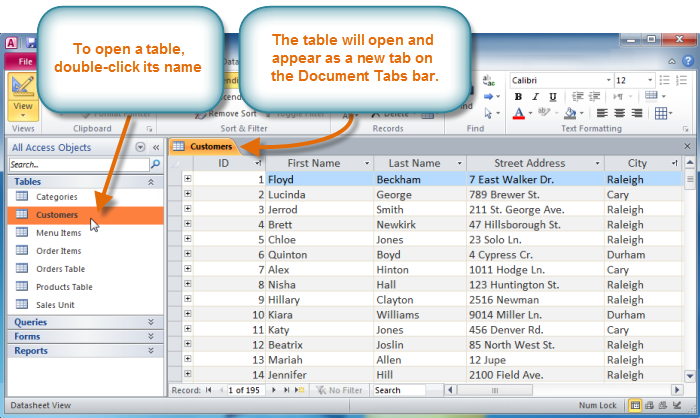 Opening a table
Opening a tableAll tables are composed of horizontal rows and vertical columns, with small rectangles called cells in the places where rows and columns intersect. In Access, rows and columns are referred to as records and fields.
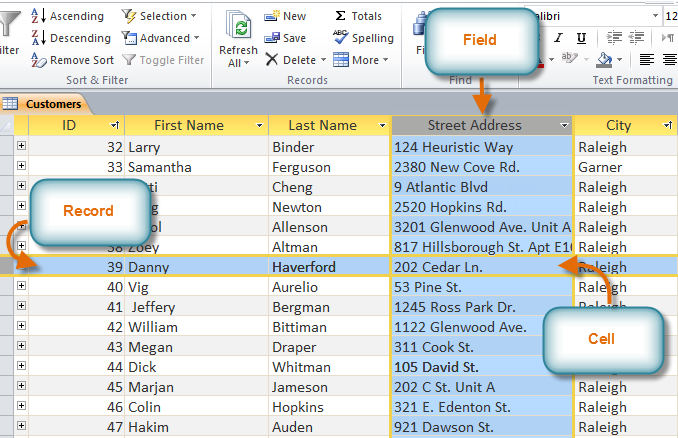 Records, fields, and cells in an Access table
Records, fields, and cells in an Access tableA field is a way of organizing information by type. Think of the field name as a question, and every cell within that field as a response to that question.
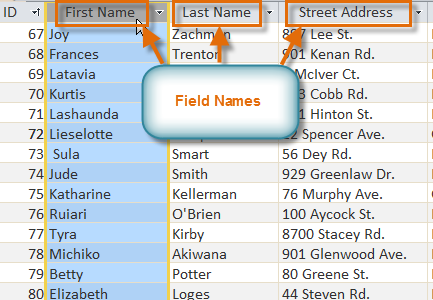 Fields and field names
Fields and field namesA record is one unit of information. Every cell on a given row is part of that row's record. Each record has its own ID number. Within a table, each ID number is unique to its record and refers to all of the information within that record. The ID number for a record cannot be changed.
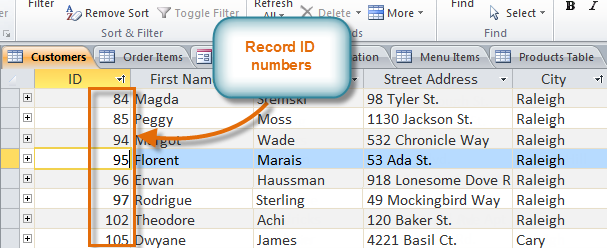 Records and record ID numbers
Records and record ID numbersEach cell of data in your table is part of both a field and a record. For instance, if you had a table of names and contact information, each person would be represented by a record, and each piece of information about each person—name, phone number, address, and so on—would be contained within a distinct field on that record's row.
Click the buttons in the interactive below to learn how to navigate a table.
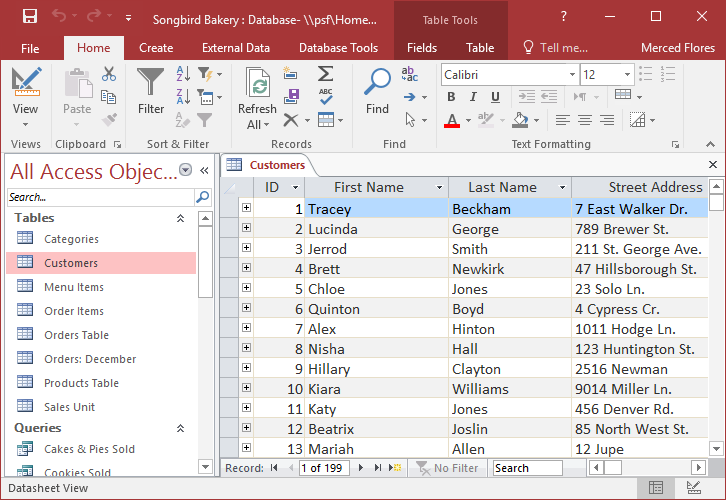
To navigate between fields, you can use the left and right arrow keys or scroll left and right.
Entering data into tables in Access is similar to entering data in Excel. To work with records, you'll have to enter data into cells. If you need help entering data into records, you may want to review our Cell Basics lesson from our Excel 2010 tutorial.
There are three ways to add a new record to a table:
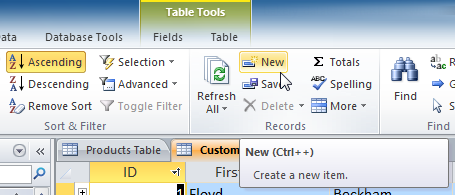 Adding a new record from the Ribbon
Adding a new record from the Ribbon Adding a new record from the Record Navigation bar
Adding a new record from the Record Navigation bar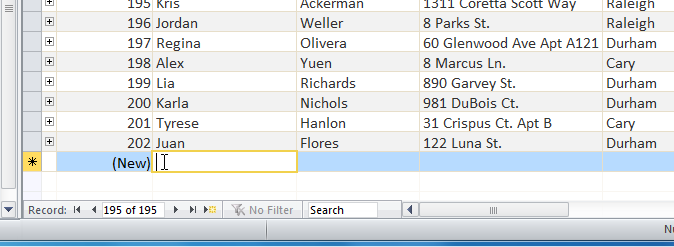 Adding a new record by typing in the row under the last record
Adding a new record by typing in the row under the last recordOccasionally when you enter information into a record, a window will pop up to tell you the information you've entered is invalid. This means the field you're working with has a validation rule, which is a rule about the type of data that can appear in that field. Click OK, then follow the instructions in the pop-up window to re-enter your data.
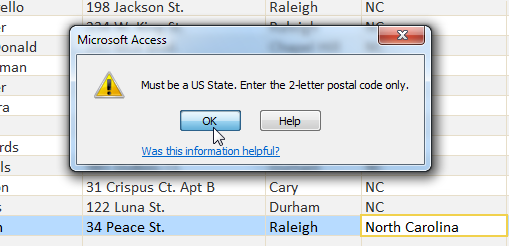 An example of a validation warning
An example of a validation warning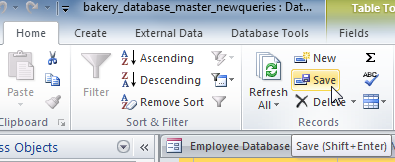 Saving a record
Saving a recordBe sure to save any unsaved records before closing a table. Access will not prompt you to save them when you close the table.
To quickly edit any record within a table, simply click it and type your changes. However, Access also offers you the ability to find and replace a word within multiple records, as well as to delete records entirely.
You can edit multiple occurrences of the same word by using Find and Replace, which searches for a term and replaces it with another term.
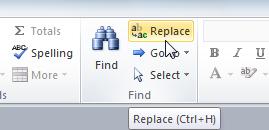 The Replace command
The Replace command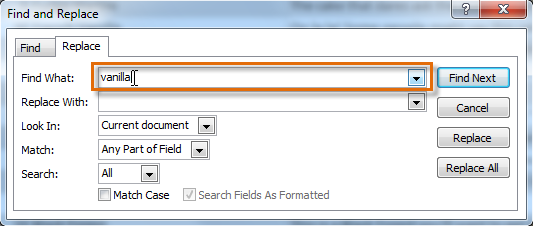 Entering the term to find
Entering the term to find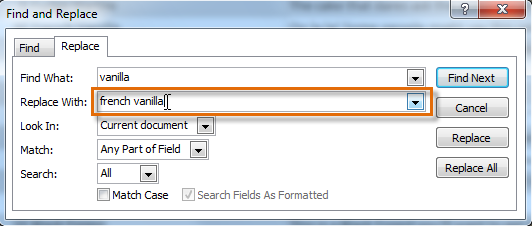 Entering the replacement text
Entering the replacement text Choosing where in the table to look
Choosing where in the table to look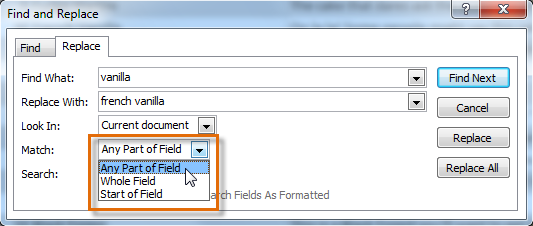 Choosing how closely the records should match your search
Choosing how closely the records should match your search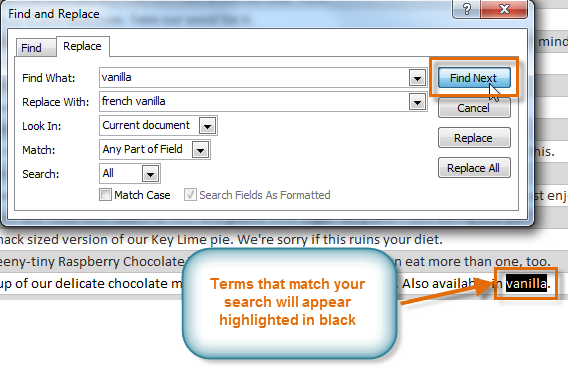 Clicking Find Next to view the next match for your search
Clicking Find Next to view the next match for your search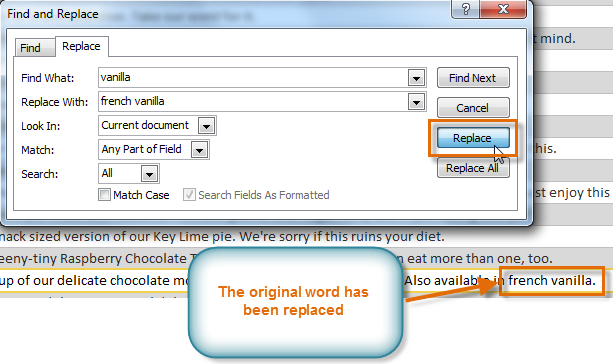 Replacing the original word with a new one
Replacing the original word with a new oneWhile you can use Replace All to replace every instance of a term, replacing them one at a time allows you to be absolutely certain you edit only the data you want. Replacing data unintentionally can have a negative impact on your database.
 The unintended consequences of choosing Replace All
The unintended consequences of choosing Replace All Selecting a record
Selecting a record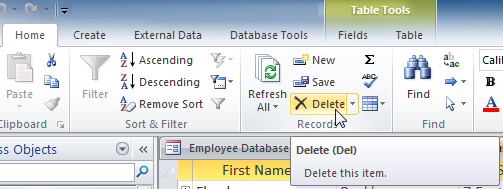 The Delete Command
The Delete CommandThe ID numbers assigned to records stay the same even after you delete a record. For example, if you delete the 34th record in a table, the sequence of record ID numbers will read ...32, 33, 35, 36... rather than ...32, 33, 34, 35, 36...
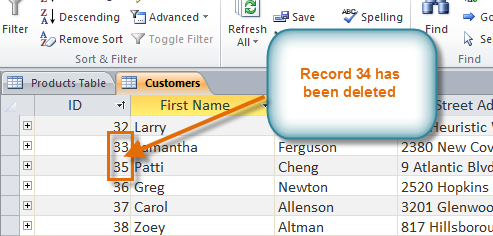 A missing ID number after a record has been deleted
A missing ID number after a record has been deleted
Access 2010 offers several ways to modify the appearance of tables. These changes aren't just about making your table look nice; they can make the table easier to read too.
If your fields and rows are too small or large for the data contained with them, you can always resize them so all of the text is displayed.
 .
.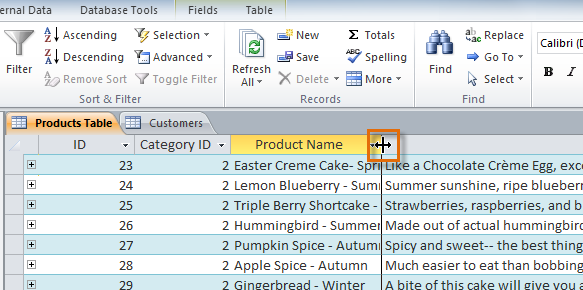 Resizing a field
Resizing a field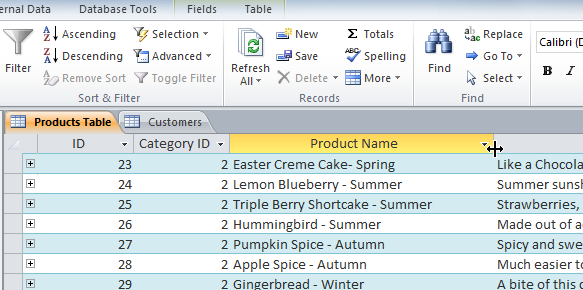 The resized field, now with all the text fully displaying
The resized field, now with all the text fully displaying .
.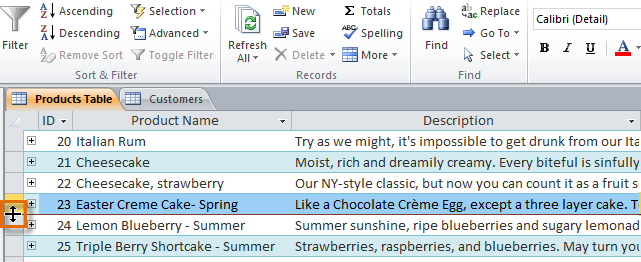 Resizing a row
Resizing a row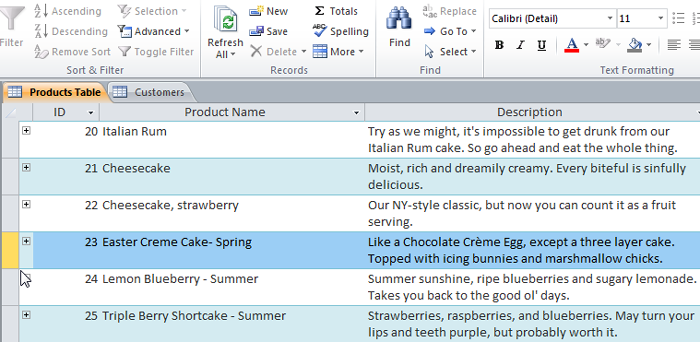 The resized row, now with all the text fully displaying
The resized row, now with all the text fully displayingIf you have a field you don't plan on editing or don't want other people to edit, you can hide it. A hidden field is invisible but is still part of your database. Data within a hidden field can still be accessed from forms, queries, reports, and any related tables.
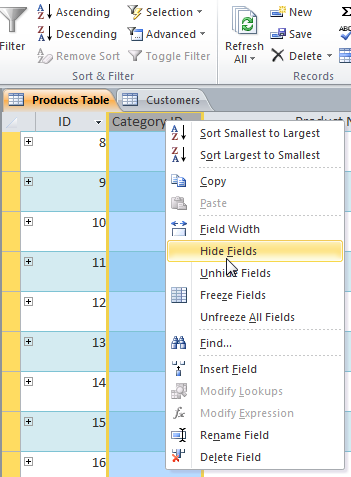 Hiding a field
Hiding a fieldIf you decide you would like the field to be visible again, you can unhide it. Simply right-click any field title, then select Unhide Fields. In the dialog box, click the check boxes of any fields you would like to be visible again, then click Close.
 Unhiding a hidden field
Unhiding a hidden fieldBy default, the background of every other row in an Access table is a few shades darker than the background of the rest of the table. This darker alternate row color makes your table easier to read by offering a visual distinction between each record and the records directly above and below it.
 A table with alternate row colors
A table with alternate row colors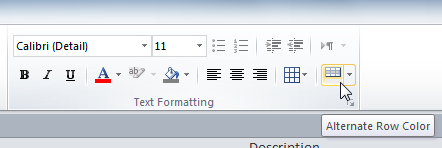 The Alternate Row Color drop-down arrow
The Alternate Row Color drop-down arrow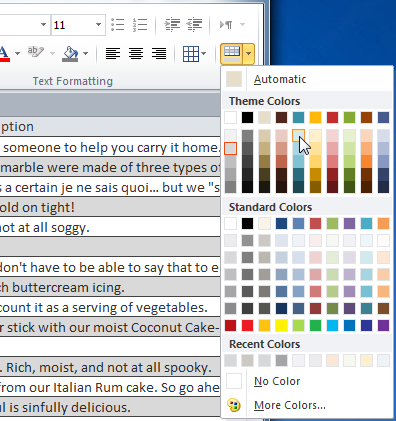 The Alternate Row Color drop-down color menu
The Alternate Row Color drop-down color menu The updated alternate row color
The updated alternate row colorAnother way Access makes your tables easier to read is by adding gridlines that mark the borders of each cell. Gridlines are the thin lines that appear between each cell, row, and column of your table. By default, gridlines are dark gray and appear on every side of a cell, but you can change their color or hide undesired gridlines.
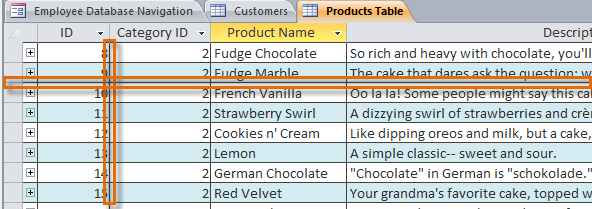 Horizontal and vertical gridlines
Horizontal and vertical gridlines The Gridlines drop-down arrow
The Gridlines drop-down arrow Selecting horizontal gridlines
Selecting horizontal gridlines The updated horizontal-only gridlines
The updated horizontal-only gridlinesTo view additional formatting options, click the Datasheet Formatting arrow in the bottom-right corner of the Text Formatting group.
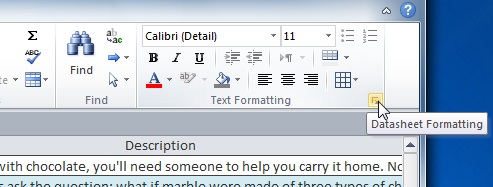 The Datasheet Formatting arrow
The Datasheet Formatting arrowThe Datasheet Formatting dialog box offers several advanced formatting options, including the ability to modify background color, gridline color, and border and line style. It even includes the ability to view a sample table with your formatting choices, so play around with the various formatting options until you get your table looking the way you want it.
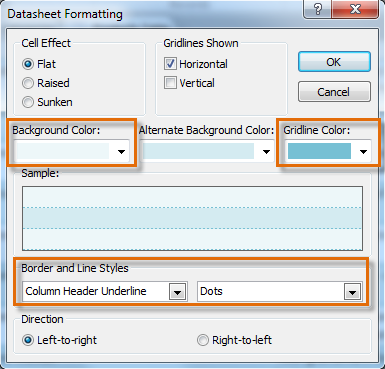 Changing the table background color, gridline color, and border and line style
Changing the table background color, gridline color, and border and line style
/en/access2010/working-with-forms/content/